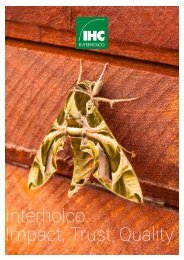Nomenclature Générale des Bois Tropicaux - 7ème édition
(english description below) Cette nomenclature est utilisée pour la mise à jour du 'Harmonized Code System' de l’Organisation Mondiale des Douanes. Dans la circulaire du 5 avril 2005, le Ministère de l’Economie, des Finances et de l’Industrie (France) reconnaît l’ATIBT comme « gardien du temple » de la nomenclature des bois tropicaux. La Commission Européenne mentionne la nomenclature de l’ATIBT comme document de référence pour la mise en œuvre du RBUE. Depuis 1954, l’ATIBT a établi et mis à jour une nomenclature des bois tropicaux faisant correspondre chaque espèce botanique avec un nom pilote reconnu internationalement. La détermination du nom pilote d’une essence est cruciale, car sa commercialisation dépend très largement de l’adoption de ce nom par le public. Le nom pilote assure la protection de l’appellation commerciale de l’essence et l’intégrité des propriétés qui lui sont attribuées, sans risque de confusion. The 1982 version of the general timber nomenclature has finally been updated as some of the 1,750 identified species, are no longer traded, while others, which were not previously included, are now on the market. The present revision has also integrated changes related to new taxonomy, in order to reflect the latest scientific developments. This Nomenclature has been used for the Harmonized Code System, updated by the World Customs Organization. The French Ministry of economy, finance and industry has given official recognition to ATIBT as the reference for the tropical timber nomenclature (NOR: PRMX0508285C of April 5th 2005). The European Commission refers to ATIBT nomenclature as a reference document for the implementation of the EUTR regulation. Since 1954, ATIBT has established and updated a nomenclature of tropical wood, linking each botanical species with an internationally recognized pilot name. A sigle wood species may have many common names; when trading across different countries, this may lead to confusion. Fixing the pilot name of a timber species is crucial, to protect the commercial denomination of the species and guarantee the veracity of the properties linked to that species, without confusion.
(english description below)
Cette nomenclature est utilisée pour la mise à jour du 'Harmonized Code System' de l’Organisation Mondiale des Douanes. Dans la circulaire du 5 avril 2005, le Ministère de l’Economie, des Finances et de l’Industrie (France) reconnaît l’ATIBT comme « gardien du temple » de la nomenclature des bois tropicaux. La Commission Européenne mentionne la nomenclature de l’ATIBT comme document de référence pour la mise en œuvre du RBUE.
Depuis 1954, l’ATIBT a établi et mis à jour une nomenclature des bois tropicaux faisant correspondre chaque espèce botanique avec un nom pilote reconnu internationalement. La détermination du nom pilote d’une essence est cruciale, car sa commercialisation dépend très largement de l’adoption de ce nom par le public. Le nom pilote assure la protection de l’appellation commerciale de l’essence et l’intégrité des propriétés qui lui sont attribuées, sans risque de confusion.
The 1982 version of the general timber nomenclature has finally been updated as some of the 1,750 identified species, are no longer traded, while others, which were not previously included, are now on the market. The present revision has also integrated changes related to new taxonomy, in order to reflect the latest scientific developments.
This Nomenclature has been used for the Harmonized Code System, updated by the World Customs Organization. The French Ministry of economy, finance and industry has given official recognition to ATIBT as the reference for the tropical timber nomenclature (NOR: PRMX0508285C of April 5th 2005). The European Commission refers to ATIBT nomenclature as a reference document for the implementation of the EUTR regulation.
Since 1954, ATIBT has established and updated a nomenclature of tropical wood, linking each botanical species with an internationally recognized pilot name. A sigle wood species may have many common names; when trading across different countries, this may lead to confusion. Fixing the pilot name of a timber species is crucial, to protect the commercial denomination of the species and guarantee the veracity of the properties linked to that species, without confusion.
Create successful ePaper yourself
Turn your PDF publications into a flip-book with our unique Google optimized e-Paper software.
152 ///
Nomenclature générale des bois tropicaux 2016
Acronymes et abréviations / Acronyms and abbreviations
AFD :
Agence Française de Développement / French Development Agency
ATIBT : Association Technique Internationale des Bois Tropicaux / International Technical Tropical
Timber Association
CITES : Convention on International Trade in Endangered Species / Convention sur le commerce international
des espèces de faune et de flore sauvages menacées d’extinction
CIRAD : Centre de Coopération International en Recherche Agronomique pour le Développement /
International Cooperation Centre in Agronomic Research for Development
CTFT :
FAO :
FFEM :
EUTR :
Centre Technique Forestier Tropical / Tropical Forestry Technical Centre
Food Agriculture Organization / Organisation des Nations Unies pour l’alimentation et l’agriculture
Fonds Français pour l’Environnement Mondial / French Fund for Global Environment
European Union Timber Regulation
GxABT : Gembloux Agro-Bio Tech - Université de Liège
HS :
ITTO :
Harmonized System
International Timber Trade Organization
MAAF : Ministère de l’Agriculture, de l’Agroalimentaire et de la Forêt / The Ministry of Agriculture,
Agrifood and Forestry
OIBT :
OMD :
RBUE :
WALE :
WCO :
Organisation Internationale des Bois Tropicaux
Organisation Mondiale des Douanes
Réglement Bois de l’Union Européenne
Wood And Logistics Expert
World Customs Organization
Conception, réalisation :
In Quarto, www.inquarto-conseil.fr
Tèl. 02.31.35.76.95
Imprimé sur papier FSC par un imprimeur détenant le label Imprim’vert.
Achevé d’imprimer par CPI Books
Dépôt légal : avril 2016














